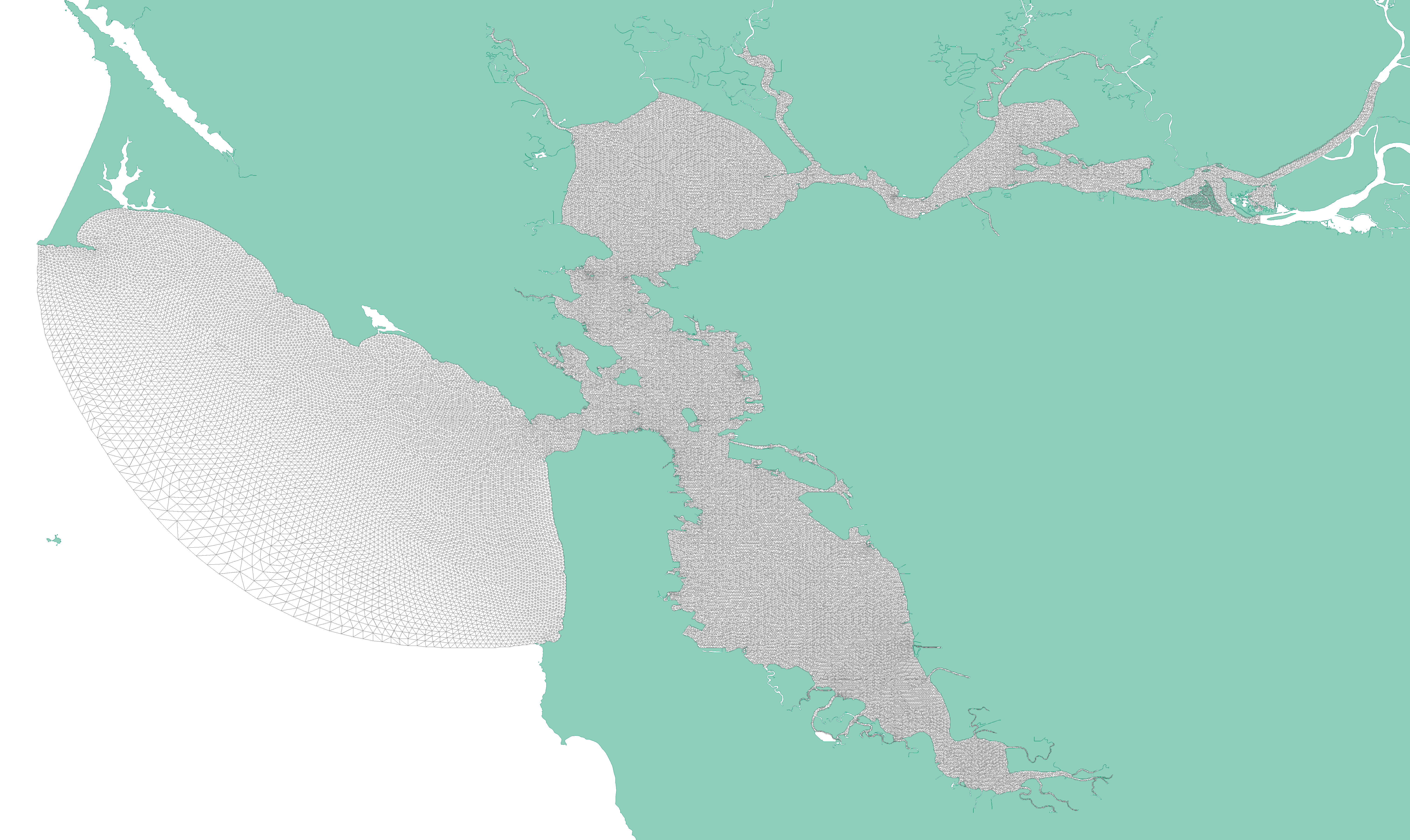San Francisco Bay Operational Forecast System (SFBOFS)
Oceanographic nowcasts and forecast guidance are scientific predictions about the present and future states of a water body (generally including water levels, currents, water temperature and salinity). These predictions rely on either observed data or forecasts from large-scale numerical models. A nowcast incorporates recent (and often near real-time) observed meteorological, oceanographic, and/or river flow rate data and/or analyzed (e.g. gridded) meteorological and oceanographic products. A nowcast covers the period of time from the recent past (e.g., the past few days) to the present, and it can make predictions for locations where observational data are not available. Forecast guidance incorporates meteorological, oceanographic, and/or river flow rate forecasts and makes predictions about the future states of a water body. A forecast is usually initiated by the state of a nowcast.
The wind data used to run SFBOFS are based on the National Weather Service (NWS) nested, high resolution (4 km) North American Mesoscale (NAM) weather prediction model winds (for the nowcast and forecast). The NCEP's operational meteorological forecast products of Global Forecast System (GFS) are used as a backup for NAM.
Additionally, SFBOFS relies on CO-OPS' real-time water level, temperature and salinity observations, the Global Operational Real-Time Ocean Forecast System (G-RTOFS) at the National Centers for Environmental Prediction (NCEP), which is based on an eddy resolving 1/12° global HYCOM (HYbrid Coordinate Ocean Model), U.S. Geological Survey (USGS) river data. The Oregon State University Tidal Inversion Software (OTIS) Regional Tide Solutions (2010) west coast tidal data wc2010 1/30° is used to provide offshore boundary conditions for the M², S², N², K², K¹, O¹, P¹, and Q¹ tidal constituents. The NOS harmonically analyzed Ssa and Sa long period constituent values at 941-5020, Point Reyes, CA, were used along the entire open ocean boundary. NWS Extratropical Storm Surge (ETSS) forecasts and the Navy's global operational HYCOM forecasts are used as a backup for open boundary conditions, and daily mean river climatologic discharges and water temperature are used as a backup for river forcing if no real-time observations are available.
The SFBOFS grid has 54,120 nodes and 102,264 elements and includes the near shelf from Point Reyes (north) to Point San Pedro (south), the entrance of San Francisco Bay, and the complete bay system (Suisin Bay, San Pablo Bay and Central and South Bays). The grid has a minimum depth of 0.2 m and maximum depth of 106.8 m. Grid resolution ranges from 3.9 km on the open ocean boundary to approximately 100 m near the coast, indicating the flexibility of the grid size based on bathymetry from the deep ocean to the coast. Additionally, the higher resolution along the navigational channels within the bay, from approximately 100 m to 10 m, provides detailed current features. The entire SFBOFS grid and spatial coverage is indicated above. The San Francisco Bay bathymetry is indicated below.
SFBOFS output is displayed in two separate subdomains; the first encompasses the whole of the SFBOFS grid (as shown above) and the second focuses on the entrance of San Francisco Bay.
SFBOFS runs on NOAA's High Performance Computers (HPC) in a new Coastal Ocean Modeling Framework (COMF) developed by CO-OPS. As a result, SFBOFS has direct access to NWS operational meteorological products that it needs to run reliably. Nowcast and forecast guidance cycles are run 4 times a day (every 6 hours).
SFBOFS output is in NetCDF format. An archive of SFBOFS NetCDF nowcast and forecast files can be accessed from THREDDS server.
All CO-OPS official real-time products, including nowcast and forecast guidance from SFBOFS are monitored by the CO-OPS's Continuous Operational Real-Time Monitoring System (CORMS). CORMS provides 24 hour per day, 7 day per week monitoring and quality control of sensors and data in order to ensure the availability, accuracy, and quality of tide, water level, current, and other marine environmental information. CORMS is intended to identify invalid and erroneous data and information before application of the data by real-time and near real-time users.
The San Francisco Bay Operational Forecast System (SFBOFS) has been implemented by NOAA's National Ocean Service (NOS) to provide the maritime user community with short-term predictions of water levels, water currents, water temperatures and salinity of the San Francisco Bay. SFBOFS uses a numerical hydrodynamic model to generate the nowcast and forecast information; therefore, they should be considered as model-generated nowcast and forecast guidance.

